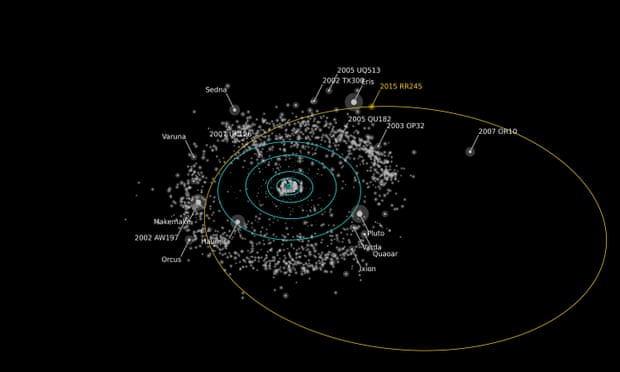Astrónomos del programa Orígenes del Sistema Solar Exterior (OSSOS, según sus siglas en inglés), con el Telescopio Francia-Hawaii-Canadá, en Hawaii, EEUU, han descubierto un nuevo objeto del Sistema Solar más allá de Neptuno, también conocido como objeto transneptuniano. Por sus grandes dimensiones ha sido clasificado como "planeta enano". Este objeto ha sido bautizado como 2015 RR245, aunque pasado un tiempo se le pondrá un nombre "más común", teniendo el programa OSSOS preferencia a la hora de renombrarlo.
El cuerpo fue identificado como un "pequeño punto de luz moviéndose", en febrero de 2016, pero fue ya observado por el Telescopio en septiembre de 2015. Sus principales características son que tiene unos 700 km de ancho, tarda 700 años en dar una vuelta al Sol, tiene una órbita bastante excéntrica (altamente elíptica) y descentrada con respecto a los planetas convencionales u otros planetas enanos, está a una distancia media del Sol de más de 12000 millones de km, 80 UA, lo que implica que está 80 veces más alejado del Sol que la Tierra. Todavía no se conocen sus dimensiones exactas, por lo que podría ser un mundo pequeño y brillante o grande y apagado. En este momento se está acercando a su distancia más cercana al Sol (perihelio), a 5000 millones de km del Sol (34 UA), la cual alcanzará en 2096. Su geología se piensa que es exótica y helada, similar a la de Plutón o Eris. Todos estos datos son aproximados, dado que solo se ha estudiado durante un breve periodo de tiempo.
El estudio de todos estos mundos aporta más información para descubrir cómo se formó el Sistema Solar. Normalmente estos mundos son tan pequeños porque descienden de planetas más grandes que fueron destruidos cuando los gigantes gaseosos (Júpiter, Saturno, Urano y Neptuno) fueron acercándose al Sol, en un periodo de cientos de millones de años. Todos estos cuerpos se agrupan en la Nube o Cinturón de Kuiper, entre los que destacan Plutón, Caronte (luna de Plutón), Eris (ver http://andres96cmc.blogspot.com.es/2013/01/el-planeta-enano-eris.html), Haumea, Varuna, Quaoar, Makemake (ver http://andres96cmc.blogspot.com.es/2013/01/el-planeta-enano-makemake.html), Orcus, Ixion o Sedna. Se cree que este objeto será el último en ser distinguido claramente de otros objetos del Cinturón de Kuiper antes de que se fabrique una nueva generación de telescopios más potentes.
Astronomers from the Outer Solar System Origins Survey (OSSOS) with the France-Hawaii-Canada Telescope in Hawaii, USA, have discovered a new object in the Solar System beyond Neptune, also known as transneptunian object. According to its great size it has been classified as a "dwarf planet". The object has been called 2015 RR245, although it will be renamed with a "more common" name in an early future, having preference in choosing the researchers from OSSOS.
The body was identified as "a small dot of light moving", in February 2016, but it was already observed in September 2015. Its main features are that it measures about 700 km of width, it spends 700 years to perform an orbit around the Sun, it has quite an excentric orbit (highly elliptic) and far from the centre of the orbits of the conventional planets or other dwarf planets, being at an average distance of 12 billion km from the Sun (80 AU, meaning that the object is 80 times further from the Sun than the Earth is). The exact dimensions are not known yet, so it could be a small and bright world or a large and dark one. Now it is coming closer to the Sun, reaching the closest distance to the Sun in 2096, 5 billion km away from the Sun (34 AU). Its geology is thought to be exotic and frozen, as happens in Pluto or Eris. All these data are approximated, as the time of study has been quite short.
The study of all these worlds brings more information to discover how the Solar System was formed. Normally, all these worlds are so small because they com from previous planets destroyed when the gas giants (Jupiter, Saturn, Uranus and Neptune) came closer to the Sun, in hundreds of millions of years' time. These bodies are all in the Kuiper Cloud or Belt, among which is important to mention bodies as Pluto, Charon (Pluto's moon), Eris (see http://andres96cmc.blogspot.com.es/2013/01/el-planeta-enano-eris.html), Haumea, Makemake (see http://andres96cmc.blogspot.com.es/2013/01/el-planeta-enano-makemake.html), Quaoar, Orcus, Ixion, Varuna or Sedna. It is thought that this object will be the last one discovered before a new generation of more powerful telescopes is made.
Para más información / For more information: http://www.abc.es/ciencia/abci-descubren-nuevo-mundo-mas-alla-neptuno-201607120951_noticia.html
En amarillo, órbita aproximada de 2015 RR245 en el Sistema Solar, siendo comparada con la órbita de otros objetos del Cinturón de Kuiper / In yellow, approximate orbit of 2015 RR245 in the Solar System, being compared with the orbit of other objects in Kuiper Belt

No hay comentarios:
Publicar un comentario